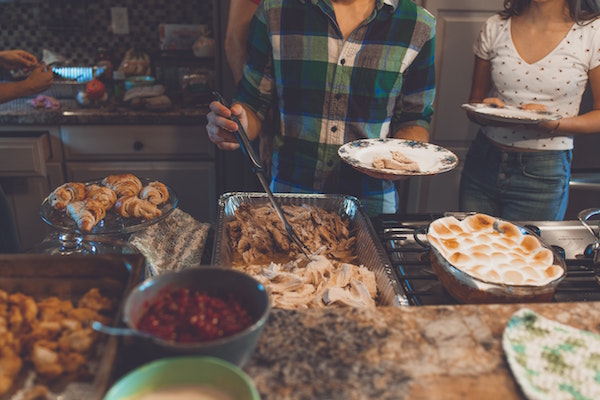
Ah, bulking.
There aren’t many things more exciting than the day you decide to stop cutting (or losing fat) and start bulking (and gaining muscle).
You get to:
- Eat more food
- Get significantly stronger in the gym
- Just enjoy your life a whole lot more
But when is the right time to do it?
There are two ways to break it down. You can start bulking when you hit a certain body fat percentage or level of leanness, or you can simply start bulking at a certain time of year on a regular basis.
My best advice for most people would be to cut until you’re lean enough to have some definition in your midsection, around 10-12% body fat for men and 16-19% for women.
As for bulking season, the best time to start packing on size is almost always in the fall and winter.
But let’s take a little bit of a closer look so you can figure out when the right time to start bulking is for you.
Leaning Down Before a Bulk (What Body Fat Percentage to Shoot For)
Unless you’re training specifically for strength — ie you want to become a powerlifter or strong man competitor — I believe most people will get the most bang for their buck by leaning down significantly right off the bat.
While some of us are extremely skinny and desperately need to add size, a large majority of people have a few pounds (or more) of fat to lose in order to look our best.
Not only that but gaining enough muscle to make a noticeable difference in your appearance is an agonizingly slow process.
(The most muscle you can reasonably expect to gain is about 1-2 pounds per month.)
You can easily, however, lose 1-2 pounds of fat per week on a proper cut. That’s around 4x faster results.
So the benefits of cutting a significant chunk of your extra fat off before bulking are:
- Quickly improve your physique
- Get motivated by faster results
- Give yourself a little room to gain fat while bulking
What’s a good body fat percentage to start bulking?
There’s no concrete answer for this, and it will vary by each individual.
If you’re significantly overweight and it takes a long, brutal cut to get down to about 15% body fat (for men) or 22% (for women) — this is a healthy, relatively trim, and athletic level of body fat — you may be ready for a break from dieting.
People who are already a little slimmer may only have to lose a few pounds to get to a lean and chiseled 10% (men) or 16% (women).
For most people, I’d keep cutting and losing fat until you’ve trimmed most of the unwanted fat off of your belly and mid-section. You don’t necessarily need to go all the way to shredded abs, but you’re going to gain a little bit of fat during your bulk and you’ll want to account for that ahead of time.
(If you’ve been dieting for a while and still aren’t there yet, you might be interested in a short refeed period or diet break before resuming your cut.)
Doing a proper and successful cut is a much bigger topic than this article can cover, but I personally like to keep it pretty simple:
- Bodyweight x 11-12 calories per day
- High protein (.8-1g of protein per day per pound of bodyweight)
- Heavy strength training (not super high reps and volume!)
- Occasional strategic refeeds (not cheat days!)
So to sum up, I think most people will see the best results getting pretty lean before they go into a bulk.
However, some people like to time their bulks and cuts by season, rather than by their physique.
Cutting in the Summer, Bulking in the Winter

You’re going to want to get in the mindset that lifting weights and improving your physique is a lifelong journey.
Yes, you can cut off a bunch of fat and get shredded in the relative short term, but packing on muscle and getting the combination of size and definition that you want will probably take years.
That’s why it’s helpful to have different goals at different points of the year.
The best time to cut, or lose fat, is undoubtedly the spring and summer. Here’s why:
- Get lean for vacation, the pool, the beach, etc.
- Weather is usually warm, and being at a lower body fat percentage won’t bother you
- Easier to stay active, burn more calories, and be distracted from eating too much
As far as cutting or fat loss goes, I’d probably start in the early spring so you can see some nice progress by the time pool weather starts.
You can also give yourself a couple-week head start before a big vacation.
If you need to, you could cut all summer long, but the ideal scenario would be to get nice and lean early on in the summer and then move into a maintenance phase.
After all, summers are great for barbeques and day-drinking! You don’t want to completely deprive yourself all summer long.
When the pools start to close up and the weather begins to cool down, it can mean only one thing: It’s bulking season.
Yes, most people should start thinking about starting a bulk as summer turns into fall.
Here’s why the fall is the perfect time to start your bulk:
- You’ll have your shirt off less often and can afford some fat gain
- You’ll eat a lot more food around the holidays, might as well turn it into muscle!
- There’s less to do in the fall and winter, so you’ll naturally want to eat more
- Higher body fat will keep you a little warmer in the winter
This is not a hard and fast rule — you can bulk and cut whenever you want!
However, it just makes too much sense not to try it, at least. Get lean in the summer and bulk up in the fall and winter. That’s pretty much the way to do it!
How to Do a Proper Lean Bulk
You’ve probably noticed a lot of the decision of when to bulk is based on your body fat levels or the thought that you’ll end up adding fat when you bulk.
This is true, but it’s worth talking about how to minimize fat gain during a bulk.
It is absurdly easy to completely overdo it while bulking. In the name of getting stronger, you’ll end up eating way too much food and ballooning up while only gaining a small amount of muscle.
This isn’t exactly ideal!
The truth is you need to be just as disciplined while bulking as you were when you were leaning down.
Here are a few helpful strategies to keep in mind:
Eat fewer calories than you think
Everyone always says “you have to eat big to get big,” and if you ask me, that’s a pretty harmful idea.
Yes, you’ll need to eat more to gain strength. And yes, you’ll need to create a calorie surplus so your body can grow new muscle.
But what you should be seeking is the minimum number of calories you can eat to get stronger on your lifts.
It might actually be pretty close to your maintenance (bodyweight x about 15), or just a hair more.
Start low and scale your calories up as needed. Don’t just jump right into eating 4000 calories a day; you’re not going to like what happens!
Stay active on rest days
If you don’t keep your calorie needs up while you eat in a surplus, you’ll find yourself with extra fat gain.
On your lifting days, push as hard as you can for new PRs and strength gains.
But on your rest days, don’t just sit around on your butt. Do some LISS (low-intensity steady state cardio) like a long walk or incline walking on the treadmill.
You’re not trying to scorch calories, just keep your body moving for better recovery and better nutrient partitioning.
Get on a good program
You can eat a ton of food and absolutely blast your muscles in the gym, and STILL not see results — if you’re doing things wrong.
There are a lot of reasons you might not be gaining strength on a bulk, but one of the big ones is that you’re on a crappy program (or none at all) and you’re not striving for progressive overload.
You can pump your muscles into oblivion, but if you’re not achieving new PRs on the bench press, for example, it’s unlikely your chest will grow. If you’re not curling more than you were two months ago, your biceps probably won’t grow.
Get on a program that utilizes a smart progression system and track all your lifts so you can know if you’re making progress, or just getting fat.
Wrapping Up
When should you start bulking? You have two choices that really make sense:
- Get lean — at least close to abs-level body fat —and then start bulking
- Cut in the summer and start bulking in the fall or early winter
But honestly, you can do it whenever you feel like it. There are no rules!
Bulking up is fun and if you’re ready to eat some calories and gain some serious strength, just go for it.
If you’re looking for a good bulking program that will help you stay lean and get crazy strong, check out my favorite bulking program for men right here.
Hope this helps!